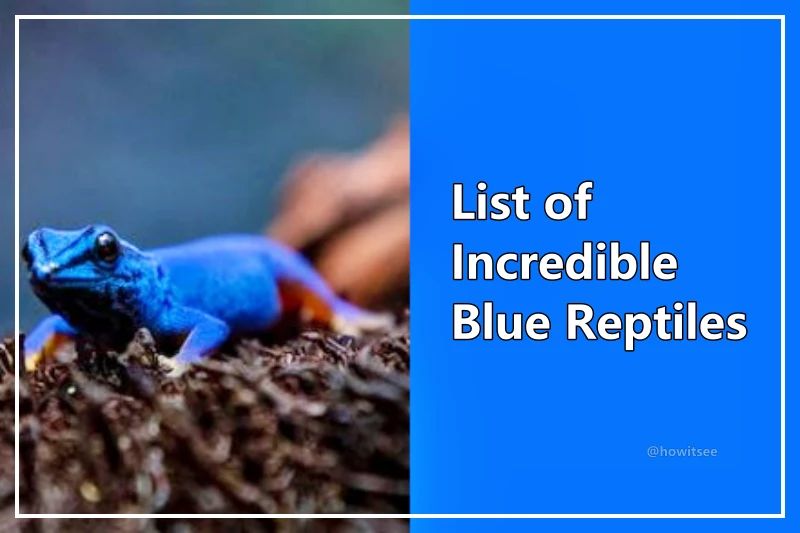Nature will always fascinate you with the changes, animals, and everything you can see with your naked eyes. In nature, you can find a variety of animals and their varied species.
Animals are well developed in camouflage to hide as per their surroundings. However, not only this, you will encounter many things as you discover more animals. You can never see an animal under camouflage until you step on them, and they bite you in return.
However, if we talk about some reptiles showing blue color, isn’t it weird to see? Many reptiles appear blue, and it is believed that the animals are not blue, but their surroundings make them look.
The number of pigments present in their body may be the reason for the blue reptiles. Let’s dive into this article and discover reptiles that appear in blue. So, without thinking another second, let’s dig into it.
Are there any Blue Reptiles?
Yes, blue reptiles exist in reality. The beautiful blue hues can be a result of morphing or can be due to the presence of specific pigments. Blue reptiles exist and are also friendly.
Several reptiles include Grand Cayman Blue Iguana, Green Tree Python- Blue Morph, Blue Panther Chameleon, and Sinai Agama.
List of 15 Incredible Blue Reptiles
1. Grand Cayman Blue Iguana
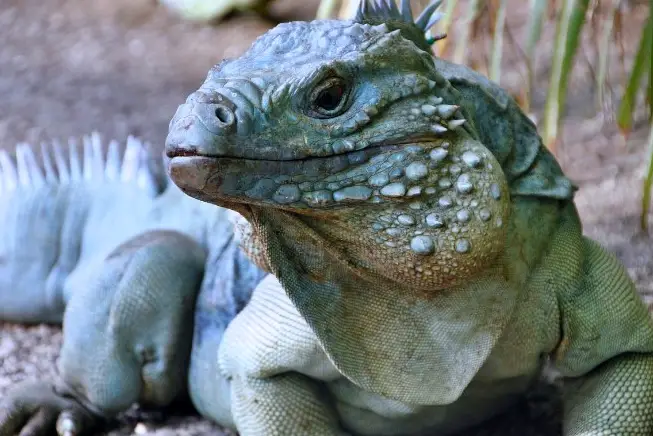
| Scientific Name | Cyclura Lewisi |
| Size | 5 feet |
| Color | Green, Blue, Violet, Grey |
| Diet | Herbivores |
| Location | Grand Cayman Island |
Commonly found in the Cayman Islands, this species is quite terrifying by its looks. Grand Cayman is a blue lizard that was at some point close to extinction.
Although you might get curious by the different shades of blue on their body, you will be surprised as they are harmless.
Grand Caymans are suitable to keep as pets and as lifelong companions. You will always be curious about their actions and unique eating habits.
As this reptile is warm-blooded, it needs warm and humid surroundings for survival.
2. Blue Tree Monitor
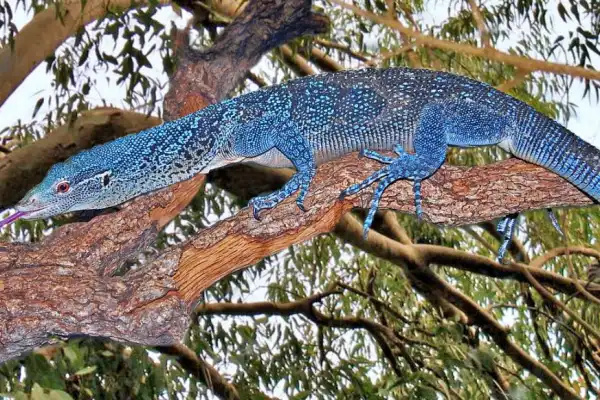
| Scientific Name | Varanus Macraei |
| Size | 3.5 feet |
| Color | Blue, Brown, Black |
| Diet | Omnivores |
| Location | Batanta Island |
Lizards are intriguing reptiles. Usually, nobody likes to keep them as close to them. Blue tree monitor lizards are blessed with a vibrant blue color that makes them attractive and suitable to keep as pets.
They are only found endemic on small islands. This lizard shows blue scales on their black colored body. You will be surprised by their commitment to you for a lifetime.
3. Green Tree Python- Blue Morph
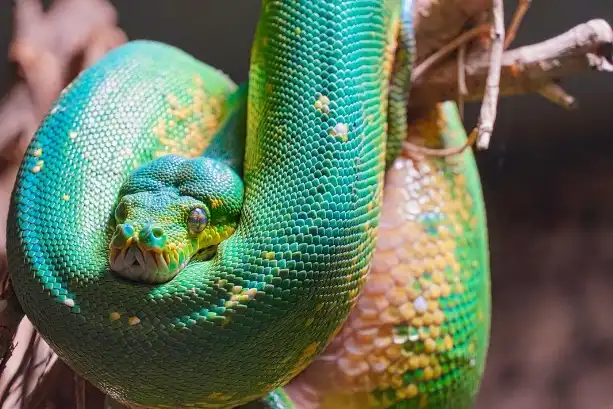
| Scientific Name | Morelia Viridis |
| Size | 4-6 feet |
| Color | Blue, White, Dark Blue |
| Diet | Carnivores |
| Location | Australia |
Snakes are amphibians that scare everyone. Python is a constructor that kills its food by constricting it to death. Green tree python is a species found in the wild.
Their coral blue color makes them unique and a suitable choice for breeding. This is a common snake type you will encounter for keeping as a pet. However, for a beginner, they are not suitable.
4. Electric Blue Gecko
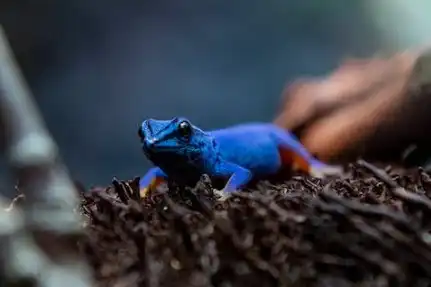
| Scientific Name | Lygodactylus Williamsi |
| Size | 6-10 cm |
| Color | Vibrant Blue Color |
| Diet | Insectivores and Frugivorous |
| Location | Tanzania |
Electric Blue Gecko comes under exotic species in reptiles. The vibrant blue color they show is the most exciting thing you can ever see in animals.
The male shows a bright blue color and is suitable to keep as a pet. Geckos are harmless to humans, so no need to worry about them. However, their immense beauty has given rise to illegal pet trading activities.
5. White Lipped Pit Viper— Blue Morph
| Scientific Name | Trimeresurus Albolabris |
| Size | 600-810 mm |
| Color | Blue, Green, White |
| Diet | Carnivores |
| Location | Indonesia |
Want to encounter a pit viper? Surely, you will be scared even though it is beautiful. Here is a white-lipped viper—- a blue reptile that is also seen as bright green in color.
Vipers are potentially venomous and can cause severe health issues in humans; they can even die too. You will always see them on the branches of the tree. Better is to make a distance from them.
6. Blue Panther Chameleon
| Scientific Name | Furcifer Pardalis |
| Size | 40-51 cm |
| Color | Blue, Green, Dark Blue |
| Diet | Insectivores |
| Location | Madagascar |
Chameleons are well-known for their perfect blended morphs. Usually, the male chameleons master the morphing technique as per the surroundings and attain a vibrant blue color.
One of the stunning color morphings is the blue shade they take. Panther Chameleons are perfect pets, and people love seeing such unique animals around.
7. Blue Anole
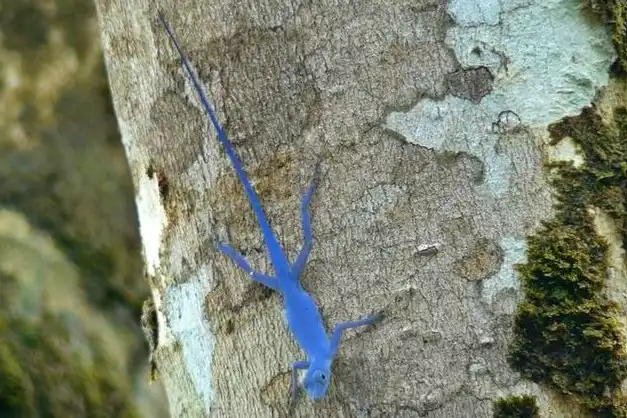
| Scientific Name | Anolis Gorgonae |
| Size | 7.5 cm |
| Color | Dark Blue, Green, White |
| Diet | Omnivores |
| Location | Colobian Pacific |
Another tiny lizard that gives you mindblowing views when seeing. The vibrant blue color makes them stand out even more than other similar reptiles.
They are usually found in Pacific islands. Blue anoles are the perfect pets you can consider, and they are also suitable to keep as pets as they are one of the smallest reptiles you can keep as pets. Anoles require extra care as they can be lost if dropped.
8. Blue Rainbow Lizard
| Scientific Name | Agama Agama |
| Size | 5.1 inches – 11.8 inches |
| Color | Vibrant Blue, Red, and Green |
| Diet | Insectivores |
| Location | Indian, Pakistan, Bangladesh |
A vivid reptile showing a variety of colors when seen in the wild. Blue rainbow lizard shows a variety of colors that shows a range of colors mostly found in Venezuela.
The clever, witty animal showing calm nature with freezing looks makes you think twice before interacting with them.
They are good to be kept as pets, but you need to take extra care of them as they are prone to extinction in the whole animal world.
9. Sinai Agama
| Scientific Name | Pseudotrapelus Sinaitus |
| Size | 7 inches |
| Color | Vibrant Blue, Green, Black |
| Diet | Carnivores |
| Location | Northeast Africa and Middle East |
Another unique yet calm creature you can witness is none other than Sinai Agama. This small deserted lizard is common in northwestern Africa.
Sinai Agamas are not suitable to be kept as pets as they are vulnerable and only seen in the wild. The blue color visible is in the males only during the mating season.
10. Common Tree Snake
| Scientific Name | Dendrelaphis Punctulatus |
| Size | Up to 2m |
| Color | Green, Blue, Yellow |
| Diet | Carnivores |
| Location | Australia |
Snakes have a variety of species. Common tree snake is very popular in Australia as they show a vibrant turquoise-blue color. There is no need to worry about these snakes as they are non-venomous and totally harmless.
Their extreme beauty is something that makes them stand out amongst other similar snakes. They are suitable to be kept as pets, but you need to be aware of them.
11. Blue Spotted Salamander
| Scientific Name | Ambystoma Laterale |
| Size | 3.5 – 5.5 inches |
| Color | Blue, Black, Golden |
| Diet | Carnivores |
| Location | Swampy areas |
Salamanders are unique animals that can be seen in the United States. The salamanders show unique color combinations in their bodies depicting the ultimate beauty you can witness.
Usually, they are dark blue with white spots on the back. However, like most amphibians, they are not suitable to be kept as pets.
12. Blue Poison Dart Frog
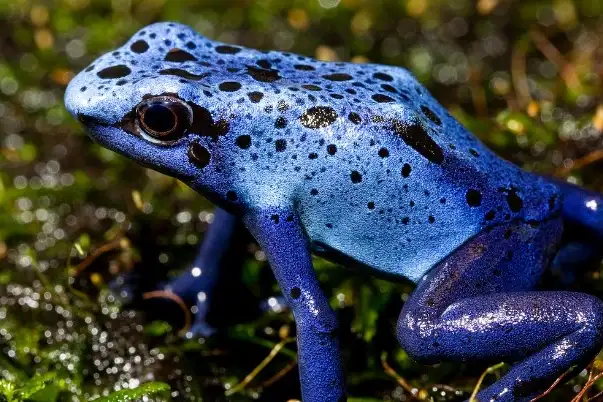
| Scientific Name | Dendrobates Tinctorius Azureus |
| Size | 2 inches |
| Color | Bright Blue, Dark Blue, Black |
| Diet | Insectivores |
| Location | Southern Suriname |
A frog can be a tasty delicacy to you but with a blue poison dart frog; you need attention. Blue poison dart frogs are necessarily venomous.
However, no one should ever dare to touch them as they can not be touched or picked up. Their poisonous nature is due to the insects they eat. These are not good to be kept as pets.
13. Tokay Gecko
| Scientific Name | Gekko Gecko |
| Size | 10 – 14 inches |
| Color | Blue, Brown, White, Grey |
| Diet | Insectivores |
| Location | Southeast Asia |
Geckos are small lizards that show calm nature. Tokay geckos are seen in bright blue color with red spots covering their body.
Tokay geckos are nocturnal animals that usually hunt in the dark. They can grow at a good pace. The keeper must provide ample space for them to grow.
These geckos don’t like being handled. Better to keep some distance if they are threatened by your presence.
14. Blue Racer
| Scientific Name | Coluber Constrictor Foxii |
| Size | 1.5 m |
| Color | Blue |
| Diet | Carnivores |
| Location | Meadows, Prairies, and Pond |
Snakes are excellent mimics that show their vulnerable side when threatened. However, blue racers are greyish-blue in color. Although they are non-venomous reptiles but are not suitable to be kept as pets.
Blue racers are easily distinguishable as they show two special scales striking the belly. They can be kept as pets, but you need extra attention as they can harm you in furious conditions.
15. Blue Lipped Sea Krait
| Scientific Name | Laticauda Laticaudata |
| Size | 910 mm |
| Color | Blue, Black |
| Diet | Carnivores |
| Location | Indian and Western Pacific Ocean |
Although, encountering any snake can be a nightmare for you. A blue-lipped sea krait is one such snake that you never want to encounter in your life. The snake shows blue color with black bands all over their body.
Blue-lipped sea kraits are extremely venomous reptiles, so it better is to avoid them as much as you can.
Conclusion
There are a variety of animals you can discover in your surroundings. The variety of colors can be quite intriguing by their exclusive color combination in nature.
The incredible blue reptiles in the world add a jewel to the colorful animal world. Because of their beautiful vibrant hues, they became a meal to many predators out there, leading to their extinction.
If you try to keep a blue reptile as your pet, always make sure to do proper research about their habitat and their nature; otherwise, you will remain confused throughout.
Also Read:

An engineering student turned into a writer. Expressing thoughts into words is what i prize the most. Being able to conclude my thoughts through my articles is my prime intention. If i am not engaging myself with animal content, you can always find me doing coding. I am an engineer by profession but a writer by heart.
